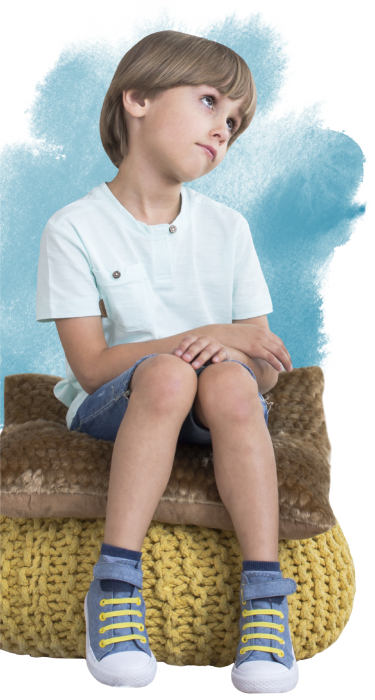Characteristic Symptoms
The essential feature of AD/HD is a persistent pattern of inattention and/or hyperactivity-impulsivity that interferes with functioning or development. Inattention manifests behaviorally in AD/HD as wandering off task, lacking persistence, having difficulty sustaining focus and being disorganized not due to defiance or lack of comprehension.
Hyperactivity refers to excessive motor activity that is not appropriate or excessive fidgeting, tapping, or talkativeness. Impulsivity refers to hasty actions that occur in the moment without forethought and that have high potential for harm to the individual. Impulsive behaviors may manifest as social intrusiveness and/or as making important decisions without consideration of long-term consequences.
Types of Attention Deficit/Hyperactivity Disorder
AD/HD is diagnosed into three subtypes based on the predominant symptom.
1. AD/HD, PREDOMINANTLY INATTENTIVE PRESENTATION
AD/HD, Predominantly Inattentive Presentation is characterized by six (or more) symptoms of inattention (but fewer than six symptoms of hyperactivity-impulsivity) that have persisted for at least six months. Children who are inattentive have a hard time keeping their minds on any one thing and may get bored with a task after only a few minutes. If they are doing something they really enjoy, they have no trouble paying attention. But focusing deliberate, conscious attention to organizing and completing a task or learning something new is difficult.

2. AD/HD, PREDOMINANTLY HYPERACTIVE PRESENTATION
AD/HD, Predominantly Hyperactive/Impulsive Presentation is characterized by six (or more) symptoms of hyperactivity-impulsivity (but fewer than six symptoms of inattention) that have persisted for at least six months. Hyperactive children always seem to be “on the go” or are constantly in motion. They dash around touching or playing with whatever is in sight or talk incessantly. Sitting still at dinner, during a school lesson, or a story can be a difficult task. They squirm and fidget in their seats or roam around the room. Or they may wiggle their feet, touch everything, or noisily tap their pencil. Hyperactive teenagers or adults may feel internally restless. They often report needing to stay busy and may try to do several things at once. Impulsive children seem unable to curb their immediate reactions or think before they act. They will often blurt out inappropriate comments, display their emotions without restraint, and act without regard for the later consequences of their conduct.
3. AD/HD, COMBINED PRESENTATION
AD/HD, Combined Presentation is characterized by six (or more) symptoms of inattention and six (or more) symptoms of hyperactivity-impulsivity that have persisted for at least six months. Most children and adolescents diagnosed with AD/HD have the combined type.
Prevalence and Age of Onset
Population surveys suggest that AD/HD occurs in about 5% of children and adolescents. AD/HD is usually first diagnosed during the elementary school years, although children with the predominantly inattentive type may not come to clinical attention until late childhood. Boys are more than twice as likely to be diagnosed with AD/HD than girls. While AD/HD is commonly thought of as a disorder involving children and adolescents, symptoms can persist fully or partially into adulthood.
Treatment & Support
There are a number of traditional (e.g., medication, behavior modification) and alternative (e.g., diet restrictions) treatment options available for AD/HD. What is important is that you determine which one is best for your child. In many instances a combination of several treatments will be most effective.
PSYCHOSTIMULANTS
The most widely used medications for the treatment of AD/HD are:
- Methylphenidate (e.g., Ritalin, Concerta, Metadate, Focalin)
- Amphetamine (e.g., Adderall, Dexedrine)
These medications are classified as stimulants and have been approved by the Food and Drug Administration (FDA) since the 1950s for treating behavioral problems in children. They appear to work by increasing activity in areas of the brain that are under-activated (e.g., frontal lobes) in children with AD/HD. This increase in brain activation causes an improvement in attention and reduces impulsiveness and hyperactivity.

Developing a fair system of consequences
BEHAVIOR MODIFICATION THERAPY
The goal of behavior modification is to increase the frequency of positive behaviors and decrease the frequency of undesirable ones. This is accomplished by:
- Clearly identifying a behavior to be changed
- Establishing reasonable expectations (setting a goal)
- Developing a fair system of consequences for success and/or failure
- Applying these standards consistently
Parents, teachers, and therapists all play a role in helping the child learn how to behave appropriately. Behavior modification is a very structured, intensive, and time-consuming approach to treatment.

A Spiritual Perspective
What does the parent struggling to care for a child with AD/HD need more than anything? Encouragement! Those who minister to children with AD/HD and their parents must be careful not to become focused only on discipline. While there are certainly heart issues that must be addressed with the child, these issues should be approached with a spirit of love. Parents are to be encouraged in the Lord, and children are to be shown that God loves them unconditionally.
Learn more about other mental health disorders.
